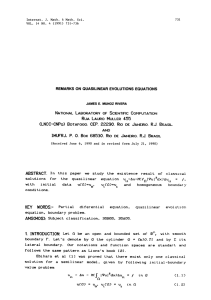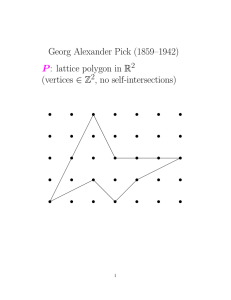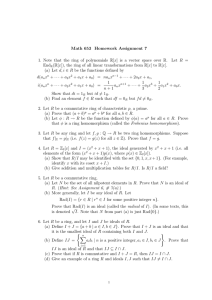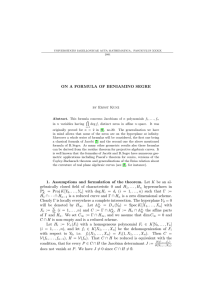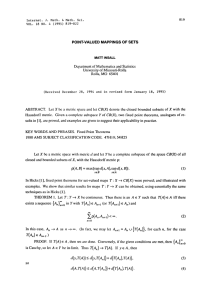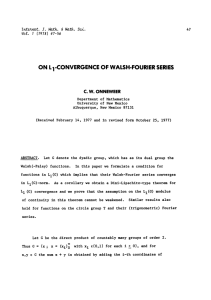EXISTENCE OF NONTRIVIAL SOLUTIONS FOR SEMILINEAR PROBLEMS WITH STRICTLY DIFFERENTIABLE NONLINEARITY
advertisement
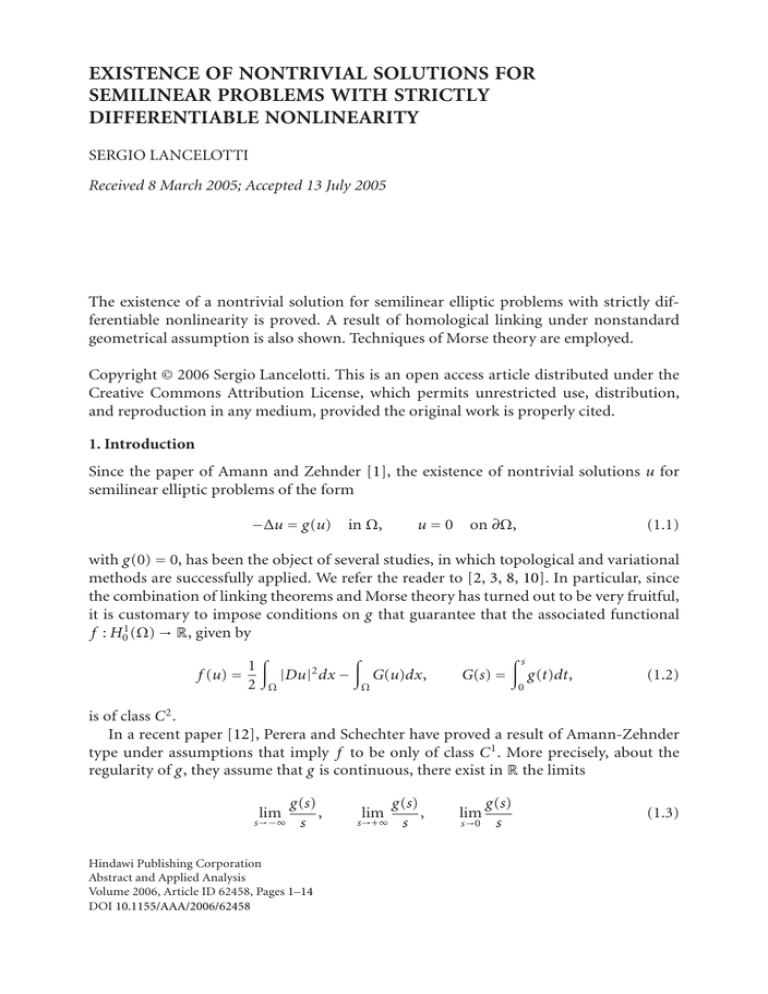
EXISTENCE OF NONTRIVIAL SOLUTIONS FOR
SEMILINEAR PROBLEMS WITH STRICTLY
DIFFERENTIABLE NONLINEARITY
SERGIO LANCELOTTI
Received 8 March 2005; Accepted 13 July 2005
The existence of a nontrivial solution for semilinear elliptic problems with strictly differentiable nonlinearity is proved. A result of homological linking under nonstandard
geometrical assumption is also shown. Techniques of Morse theory are employed.
Copyright © 2006 Sergio Lancelotti. This is an open access article distributed under the
Creative Commons Attribution License, which permits unrestricted use, distribution,
and reproduction in any medium, provided the original work is properly cited.
1. Introduction
Since the paper of Amann and Zehnder [1], the existence of nontrivial solutions u for
semilinear elliptic problems of the form
−Δu = g(u)
in Ω,
u = 0 on ∂Ω,
(1.1)
with g(0) = 0, has been the object of several studies, in which topological and variational
methods are successfully applied. We refer the reader to [2, 3, 8, 10]. In particular, since
the combination of linking theorems and Morse theory has turned out to be very fruitful,
it is customary to impose conditions on g that guarantee that the associated functional
f : H01 (Ω) → R, given by
f (u) =
1
2
Ω
|Du|2 dx −
Ω
G(u)dx,
G(s) =
s
0
g(t)dt,
(1.2)
is of class C 2 .
In a recent paper [12], Perera and Schechter have proved a result of Amann-Zehnder
type under assumptions that imply f to be only of class C 1 . More precisely, about the
regularity of g, they assume that g is continuous, there exist in R the limits
lim
s→−∞
g(s)
,
s
Hindawi Publishing Corporation
Abstract and Applied Analysis
Volume 2006, Article ID 62458, Pages 1–14
DOI 10.1155/AAA/2006/62458
lim
s→+∞
g(s)
,
s
lim
s→0
g(s)
s
(1.3)
2
Existence of nontrivial solutions for semilinear problems
and that
g(s)
is Lipschitz continuous in a neighbourhood of 0.
s
(1.4)
One could observe that hypothesis (1.4) allows f not to be of class C 2 , but it does not
include every g satisfying the usual assumption that g is of class C 1 and g is bounded. In
particular, condition (1.4) is not stable if we add to g a term of the form
|s|3/2
1 + s2
.
(1.5)
The first purpose of this paper is to extend the result of [12] in such a way that also the
classical smooth case is included. Our result is the following.
Theorem 1.1. Let Ω be a bounded open subset of Rn and g : R → R be a continuous function
satisfying g(0) = 0 and
(a) there exists C ≥ 0 such that
g(s) ≤ C 1 + |s| ;
(1.6)
(b) there exists α ∈ R such that
lim
s→±∞
g(s)
= α.
s
(1.7)
If we denote by (λm ) the sequence of the eigenvalues of −Δ with homogeneous Dirichlet
boundary condition, let us assume that α = λm for any m ∈ N. Moreover, let us suppose that
g is strictly differentiable at 0 (see Definition 3.1 below) and that there exists m ∈ N with
either g (0) < λm < α or g (0) > λm > α.
Then (1.1) admits a nontrivial solution.
Theorem 1.1 is in fact a particular case of a more general result, which will be presented
in Section 2.
Remark 1.2. If, as in [12], we have g(s) = sγ(s), with γ Lipschitz continuous in a neighbourhood of 0, then it is easy to see that g is strictly differentiable at 0.
A second purpose of the paper is to improve the saddle theorem proved in [11, Theorem 1.4], also mentioned in [12], in which the functional is of class C 2 , but nonstandard
geometrical assumptions are considered. We will prove the following.
Theorem 1.3. Let H be a Hilbert space such that H = H− ⊕ H+ with dimH− < ∞ and H+
closed in H. Let f : H → R be a functional of class C 2 and assume that
c0 = inf f > −∞,
H+
c1 = sup f < +∞,
(1.8)
H−
f satisfies (PS)c for every c ∈ [c0 ,c1 ], f (u) is a Fredholm operator at every critical point u
in f −1 ([c0 ,c1 ]).
Then there exists a critical point u of f with c0 ≤ f (u) ≤ c1 and m( f ,u) ≤ dimH− ≤
m∗ ( f ,u).
Sergio Lancelotti 3
In [11] it is only shown that there exist critical points u, u with c0 ≤ f (u) ≤ f (u) ≤
c1 and m( f ,u) ≤ dimH− ≤ m∗ ( f ,u), but one cannot say if there exists a critical point
u = u = u, as in the case with standard geometrical assumptions (see [8]), or not. Our
improvement is related to the fact that, according to Proposition 4.3 below, also under
the nonstandard geometrical assumptions of Theorem 1.3, it is possible to recognize a
homological linking structure.
The paper is organized as follows: in Section 2 we state the result of existence of nontrivial solutions; Sections 3 and 4 are devoted to prove some auxiliary results, while in
Section 5 we prove the main theorems.
2. Existence of a nontrivial solution
Let Ω be a bounded open subset of Rn and g : Ω × R → R be a Carathéodory function
satisfying
(g0 ) g(x,0) = 0 for a.e. x ∈ Ω;
(g1 ) there exists C ≥ 0 such that |g(x,s)| ≤ C(1 + |s|) for a.e. x ∈ Ω and every s ∈ R;
(g2 ) for a.e. x ∈ Ω, the function {s → g(x,s)} is strictly differentiable at 0 (see Definition
3.1 below) with Ds g(·,0) ∈ L∞ (Ω);
(g3 ) there exist C ≥ 0 and δ > 0 such that, for a.e. x ∈ Ω, we have
∀s,t ∈] − δ,δ[ : g(x,s) − g(x,t) ≤ C|s − t |.
If we set G(x,s) =
by
s
0 g(x,t)dt,
(2.1)
it is well known that the functional f : H01 (Ω) → R defined
f (u) =
1
2
Ω
|Du|2 dx −
Ω
G(x,u)dx
(2.2)
is of class C 1 .
We denote by m( f ,0) the supremum of the dimensions of the linear subspaces of
H01 (Ω) where the quadratic form
Q(u) =
Ω
|Du|2 dx −
Ω
Ds g(x,0)u2 dx
(2.3)
is negative definite, and by m∗ ( f ,0) the supremum of the dimensions of the linear subspaces of H01 (Ω) where Q is negative semidefinite. We call m( f ,0) (resp., m∗ ( f ,0)) the
strict (resp., large) Morse index of f at 0.
Theorem 2.1. Assume that H01 (Ω) = X− ⊕ X+ with dimX− < ∞ and X+ closed in H01 (Ω).
Suppose also that
c0 = inf f > −∞,
X+
and that f satisfies (PS)c for every c ∈ [c0 ,c1 ],
c1 = sup f < +∞,
X−
(2.4)
4
Existence of nontrivial solutions for semilinear problems
If it is dimX− ∈ [m( f ,0),m∗ ( f ,0)], then the problem
−Δu = g(x,u)
in Ω,
u = 0 on ∂Ω,
(2.5)
admits a nontrivial solution u.
Remark 2.2. Under the assumption of Theorem 1.1, it is well known that f satisfies (PS)c
for any c ∈ R and the geometrical assumptions of Theorem 2.1. Since it is clear that also
(g0 )–(g3 ) are satisfied, Theorem 1.1 is a consequence of Theorem 2.1.
3. Computations of critical groups
Definition 3.1. Let Φ be a map from an open subset U of a normed space X to a normed
space Y and let u ∈ U. We say that Φ is strictly differentiable at u (strongly differentiable in
the sense of [6]), if there exists a continuous linear map L : X → Y such that
Φ w1 − Φ w2 − L w1 − w2
= 0.
w1 − w2 (w1 ,w2 )→(u,u)
lim
(3.1)
w1 =w2
Of course, in such a case Φ is Fréchet differentiable at u and L = Φ (u).
Definition 3.2. Let K be a field, X be a metric space and f : X → R be a continuous
function. For u ∈ X and c = f (u), let us set
∀q ∈ Z : Cq ( f ,u) = Hq f c , f c \ {u} ,
(3.2)
where f c = {v ∈ X : f (v) ≤ c} and Hq (A,B) denotes the qth singular homology group of
the pair (A,B), with coefficients in K (see, e.g., [14]). The vector space Cq ( f ,u) is called
the qth critical group of f at u. Because of the excision property, we may replace f by f |U
for any neighborhood U of u in X.
Definition 3.3. Let X be a Banach space, U an open subset of X and f : U → R be a
function of class C 1 . Let C be a closed subset of X with C ⊆ U. We say that f satisfies
the Palais-Smale condition ((PS), for short) on C, if every sequence (uh ) in C with f (uh )
bounded and f (uh ) → 0 admits a convergent subsequence. In the case C = A = X, we
simply say that f satisfies (PS).
Let c ∈ R. We say that f satisfies the Palais-Smale condition at level c ((PS)c , for short),
if every sequence (uh ) in U with f (uh ) → c and f (uh ) → 0 admits a convergent subsequence.
Let Ω be a bounded open subset of Rn (n ≥ 3), 1 ≤ p < (n + 2)/(n − 2) and g : Ω × R →
R be a Carathéodory function satisfying
(g1 ) there exists C ≥ 0 such that |g(x,s)| ≤ C(1 + |s| p ) for a.e. x ∈ Ω and every s ∈ R.
Let u0 ∈ H01 (Ω) be an isolated weak solution of the semilinear problem
−Δu = g(x,u)
in Ω,
u = 0 on ∂Ω.
(3.3)
Sergio Lancelotti 5
By regularity theory, we automatically have u0 ∈ L∞ (Ω). Moreover, let us assume that:
(g2 ) for a.e. x ∈ Ω, the function {s → g(x,s)} is strictly differentiable at u0 (x) and
Ds g(·,u0 ) ∈ L∞ (Ω);
(g3 ) there exist C ≥ 0 and δ > 0 such that for a.e. x ∈ Ω
∀s,t ∈ ] − δ,δ[ : g x,u0 (x) + s − g x,u0 (x) + t ≤ C|s − t |.
(3.4)
Let f : H01 (Ω) → R be the functional
f (u) =
where G(x,s) =
s
0 g(x,t)dt,
1
2
Ω
|Du|2 dx −
Ω
G(x,u)dx,
(3.5)
and let Q : H01 (Ω) → R be the quadratic form
Q(u) =
Ω
|Du|2 dx −
Ω
Ds g x,u0 u2 dx.
(3.6)
Finally, let m( f ,u0 ) and m∗ ( f ,u0 ) be defined as in Section 2.
Theorem 3.4. We have that Cq ( f ,u0 ) = {0} for every q ≤ m( f ,u0 ) − 1 and every q ≥
m∗ ( f ,u0 ) + 1.
The proof will be given at the end of the section.
As a first step, we approximate the functional f with suitable functionals fλ of class
C 1 with fλ strictly differentiable at u0 and such that the critical groups of fλ at u0 are
independent of λ.
Let us denote by · q the norm of Lq (Ω) and by · 1,2 the norm of H01 (Ω).
Remark 3.5. Up to substitute g with g : Ω × R → R defined by
g(x,s) = g x,u0 (x) + s − g x,u0 (x) ,
(3.7)
we may assume that u0 = 0 and that g(x,0) = 0.
Lemma 3.6. There exists a constant C > 0 such that, for a.e. x ∈ Ω and for any s ∈ R, we
have
g(x,s) ≤ C 1 + |s| p−1 |s|.
(3.8)
Proof. If 0 < |s| < δ, then by (g3 ) it is
g(x,s) ≤ C.
s (3.9)
Otherwise, if |s| ≥ δ, then it is
g(x,s) C 1 + |s| p C
≤
≤ + C |s| p−1 .
s |s|
δ
Hence the assertion follows.
(3.10)
6
Existence of nontrivial solutions for semilinear problems
Now let δ > 0 be as in (g3 ) and ϑ ∈ Cc∞ (R) such that 0 ≤ ϑ ≤ 1, supt(ϑ) ⊆ ] − δ,δ[ and
δ δ
ϑ(s) = 1 if s ∈ − , ,
4 4
1
δ δ
0≤ϑ≤
if s ∈ [−δ,δ] \ − , .
2
2 2
(3.11)
For every λ ∈ [0,1] let us define gλ (x,s) = g(x,ϑ(λs)s) and let fλ : H01 (Ω) → R be the functional
fλ (u) =
1
2
Ω
|Du|2 dx −
Ω
Gλ (x,u)dx,
(3.12)
s
where Gλ (x,s) = 0 gλ (x,t)dt. It is clear that:
(a) for every λ > 0 and for a.e. x ∈ Ω, the function {s → gλ (x,s)} is Lipschitz continuous uniformly with respect to x;
(b) for every λ and for a.e. x ∈ Ω, the function {s → gλ (x,s)} is strictly differentiable
at 0 with Ds gλ (x,0) = Ds g(x,0);
(c) for a.e. x ∈ Ω, the functions {(λ,s) → gλ (x,s)} and {(λ,s) → Gλ (x,s)} are continuous;
(d) there exists C ≥ 0 such that |gλ (x,s)| ≤ C(1 + |s| p ), |Gλ (x,s)| ≤ C(1 + |s| p+1 ).
Theorem 3.7. The following facts hold:
(i) for every λ ∈ [0,1], the functional fλ is of class C 1 ;
(ii) there exists an open bounded neighbourhood U of 0 in H01 (Ω) such that, for every
λ ∈ [0,1], 0 is the only critical point of fλ in U;
(iii) for every λ ∈]0,1], fλ is strictly differentiable at 0 with fλ (0)v,v = Q(v).
Proof. It is readily seen that assertion (i) holds.
Let us consider assertion (ii). By contradiction, let us assume that there exist (λh ) in
[0,1] and (uh ) in H01 (Ω) with uh = 0 and uh → 0 strongly in H01 (Ω) such that fλh (uh ) = 0.
Up to a subsequence, λh → λ in [0,1]. Since uh is a critical point of fλh , we have that uh is
a weak solution of
−Δu = gλh (x,u)
in Ω,
u=0
on ∂Ω.
(3.13)
Let
⎧ ⎪
⎨ gλh x,uh
ah = ⎪
⎩0
uh
where uh = 0,
(3.14)
where uh = 0.
By Lemma 3.6 it is
p −1 p −1 gλ x,uh g x,ϑ λh uh uh ah ≤ =
≤ C 1 + ϑ λh uh uh h
.
≤ C 1 + uh uh
uh
(3.15)
Sergio Lancelotti 7
Since uh is bounded in L2n/(n−2) (Ω), then ah belongs to Lq (Ω) with q > n/2 and
a h ≤ C 1 + u h p −1
2n/(n−2) ≤ M.
q
(3.16)
Hence uh is a weak solution of the linear problem
−Δu = ah u
in Ω,
u = 0 on ∂Ω.
(3.17)
By [7, Theorem 3.13.1] uh ∈ L∞ (Ω) and there exists C > 0 such that uh ∞ ≤ C Duh 2 .
Hence uh → 0 in L∞ (Ω). Since ϑ = 1 on [−δ/4,δ/4], for h sufficiently large we have that
uh is a weak solution of (3.3). It follows that 0 is not an isolated solution of (3.3): a contradiction.
Finally, let us consider assertion (iii). Let L : H01 (Ω) → H −1 (Ω) be the continuous linear
operator such that
Lv,w = Lw,v ,
Lv,v = Q(v).
(3.18)
Let (uh ), (vh ), (wh ) in H01 (Ω) be such that uh → 0, wh → 0 in H01 (Ω) and vh 1,2 ≤ 1. Up
to a subsequence, wh → 0 and uh → 0 a.e. in Ω. We have that
f wh ,vh − f uh ),vh − L wh − uh ,vh λ
λ
gλ x,wh − gλ x,uh
− Ds g(x,0) wh − uh vh dx
=
{x∈Ω:wh (x)=uh (x)}
wh − uh
n/2 2/n
g x,w − g x,u h
λ
h
λ
− Ds g(x,0) dx
wh − uh
{x∈Ω:wh (x)=uh (x)} ≤C
(3.19)
× wh − uh 1,2 vh 1,2 .
Then it is
f wh ,vh − f uh ,vh − L wh − uh ,vh λ
λ
wh − uh 1,2
≤C
n/2 2/n
g x,w − g x,u h
λ
h
λ
vh − Ds g(x,0) dx
1,2
wh − uh
{x∈Ω:wh (x)=uh (x)}
n/2
2/n
g x,w − g x,u h
λ
h
λ
≤C
− Ds g(x,0)
χ{x∈Ω:wh (x)=uh (x)} dx
.
wh − uh
Ω
(3.20)
8
Existence of nontrivial solutions for semilinear problems
By (a) and (b) we can apply Lebesgue’s theorem, obtaining
n/2
2/n
g x,w − g x,u h
λ
h
λ
− Ds g(x,0) χ{x∈Ω:wh (x)=uh (x)} dx
−→ 0.
wh − uh
Ω
(3.21)
Therefore
fλ wh ,vh − fλ uh ,vh − L wh − uh ,vh
=0
wh − uh 1,2
lim
h→+∞
(3.22)
and assertion (iii) follows.
Theorem 3.8. The critical groups Cq ( fλ ,0) are independent of λ. In particular
∀q ∈ Z : Cq ( f ,0) ≈ Cq f1 ,0 .
(3.23)
Proof. Let U be an open bounded neighbourhood of 0 in H01 (Ω) as in assertion (ii) of
Theorem 3.7. We claim that if λh → λ in [0,1], then fλh |U − fλ|U 1,∞ → 0. Let (uh ) be a
sequence in U. Up to a subsequence, uh u in H01 (Ω) and uh → u a.e in Ω. It is
f λh uh − f λ uh =
=
Ω
Ω
Gλh x,uh − Gλ x,uh dx
Gλh x,uh − Gλ (x,u) dx +
Ω
(3.24)
Gλ (x,u) − Gλ x,uh dx.
By (c), (d) and Lebesgue’s theorem we deduce that
Ω
Gλh x,uh − Gλ (x,u) dx −→ 0.
(3.25)
Therefore fλh → fλ uniformly on U.
Now, let vh ∈ H01 (Ω) with vh 1,2 ≤ 1. Up to a subsequence vh v in H01 (Ω), vh v
in L2n/(n−2) (Ω) and vh → v a.e. in Ω. It is
f uh ,vh − f uh ,vh λh
λ
g
x,u
g
x,u
v
dx
−
=
λ
h
λ
h
h
h
Ω
g x,ϑ λh uh uh − g x,ϑ λuh uh vh dx
=
Ω
≤C
Ω
g x,ϑ λh uh uh − g x,ϑ λuh uh 2n/(n+2) dx
(3.26)
(n+2)/2n
vh .
1,2
Sergio Lancelotti 9
As before we have that
Ω
gλ x,uh − gλ x,uh 2n/(n+2) dx −→ 0.
h
(3.27)
It follows that fλh → fλ uniformly on U. Finally, since U is bounded and g has subcritical
growth, we have that for every λ ∈ [0,1] fλ satisfies (PS) in U. By [5, Theorem 5.2] the
assertion follows.
In the second part of this section we deduce from [6] a generalization of the classical
Shifting theorem (see [3, Theorem I.5.4], [10, Theorem 8.4]).
Let H be a Hilbert space, U be an open subset of H, u0 ∈ U and f : U → R be a function of class C 1 such that f is strictly differentiable at u0 and f (u0 ) is a Fredholm operator. In particular, f is Lipschitz continuous in a neighbourhood of u0 . Let L : H → H
be the linear operator defined by
∀v,w ∈ H : Lv,w = f u0 v,w ,
(3.28)
let V0 = kerL and let PV0 be the orthogonal projection on V0 . We also denote by m( f ,u0 )
(resp., m∗ ( f ,u0 )) the strict (resp., large) Morse index of f at u0 .
Theorem 3.9. Let u0 be an isolated critical point of f . Then there exist a neighbourhood U
of PV0 u0 in V0 and a function f : U → R of class C 1 with locally Lipschitz gradient such that
PV0 u0 is an isolated critical point of f and
∀q ∈ Z : Cq f ,u0 ≈
⎧
⎨Cq−m( f ,u0 ) f,PV0 u0
if m f ,u0 < ∞,
⎩{0}
if m f ,u0 = ∞,
∀q ≤ m f ,u0 − 1 : Cq f ,u0 = {0},
∀q ≥ m∗ f ,u0 + 1 : Cq f ,u0 = {0}.
(3.29)
(3.30)
Proof. Without loss of generality, we may assume that u0 = 0. From [6, Theorem 1.2] we
also see that the generalized Morse lemma holds also in this setting. Arguing as in the
proof of [10, Theorem 8.4], we find that (3.29) holds. Actually, in our case f is of class
C 2−0 instead of C 2 , but the proof of [10, Theorem 8.4] remains valid also in this case.
On the other hand, also the proof of [10, Theorem 8.5] can be easily adapted from the
C 2 to the C 2−0 case. Therefore we have that Cq ( f,PV0 u0 ) = {0} if q ≥ dimV0 + 1. Since
m∗ ( f ,u0 ) = m( f ,u0 ) + dimV0 , the other assertions follow from (3.29).
Finally, let us prove Theorem 3.4.
Proof. By Remark 3.5 we may assume that u0 = 0. Let fλ : H01 (Ω) → R be as in (3.12). By
Theorem 3.7 we have that f1 is of class C 1 with f1 strictly differentiable at 0 and 0 is an
isolated critical point of f1 . Moreover, f1 (0) is a Fredholm operator. By Theorem 3.8 it is
∀q ∈ Z : Cq ( f ,0) ≈ Cq f1 ,0 .
(3.31)
10
Existence of nontrivial solutions for semilinear problems
On the other hand, since Q(u) = f1 (0)u,u, we have that m( f ,0) = m( f1 ,0) and m∗ ( f ,
0) = m∗ ( f1 ,0). From Theorem 3.9 the assertion follows.
4. Homological linking
Throughout this section, X will denote a Banach space, Br (u) the open ball of center
u ∈ X and radius r and f : X → R a function of class C 1 . We set K = {u ∈ X : f (u) = 0}
and, for every c ∈ R,
Kc = u ∈ X : f (u) = 0, f (u) = c .
(4.1)
We also denote by H∗ singular homology.
First of all, let us recall from [4] an extension of the homological linking of [3].
Definition 4.1. Let D, S, A be three subsets of X, m ∈ N and K a field. We say that
(D,S) links A homologically in dimension m (over K), if S ⊆ D, S ∩ A = ∅ and there exists z ∈ Hm (X,S; K) belonging to the image of i∗ : Hm (D,S; K) → Hm (X,S; K) but not of
j∗ : Hm (X \ A,S; K) → Hm (X,S; K), where i : (D,S) → (X,S) and j : (X \ A,S) → (X,S) are
the inclusion maps.
It is clear that, if (D,S) links A homologically, then D ∩ A = ∅.
Theorem 4.2. Let D, S, A be three subsets of X such that (D,S) links A homologically in
dimension m and let z ∈ Hm (X,S; K) be as in Definition 4.1. Assume that
inf f > −∞,
A
sup f < +∞,
∀u ∈ S : f (u) < inf f
(4.2)
A
D
and define
c = inf b ∈ R : S ⊆ f b and z belongs to the image of the
homomorphism induced by inclusion Hm f b ,S; K −→ Hm (X,S; K) .
(4.3)
Suppose that f satisfies (PS) and that each element of Kc is isolated in K.
Then inf A f ≤ c ≤ supD f and there exists u ∈ Kc with Cm ( f ,u) = {0}.
To prove our main results we need the following.
Proposition 4.3. Let X = X− ⊕ X+ , with dimX− < ∞ and X+ closed in X. Assume that
c0 = inf f > −∞,
X+
c1 = sup f < +∞
(4.4)
X−
and that f satisfies (PS)c for every c ∈ [c0 ,c1 ].
Then there exists a compact pair (D,S) in X such that
max f ≤ c1 ,
D
∀u ∈ S : f (u) < c0
and such that (D,S) links X+ homologically in dimension dimX− over all K.
(4.5)
Sergio Lancelotti 11
Proof. Since f satisfies (PS)c for every c ∈ [c0 ,c1 ], there exists r > 0 such that K ∩ f −1 ([c0 ,
c1 ]) ⊆ (Br (0) ∩ X− ) ⊕ X+ . Moreover, there exist δ,σ > 0 such that
PX u ≥ r,
−
c0 − δ ≤ f (u) ≤ c1 + δ
=⇒ f (u) > σ,
(4.6)
where PX− denotes the projection on X− induced by the decomposition X = X− ⊕ X+ . Let
c > 0 be such that PX− u ≤ cu for any u ∈ X and let
R=c
c1 − c0 + δ
ρ2 = R − r − δ,
+ r + δ,
ρ1 = 1,
σ
C = X \ Br+ρ1 +ρ2 (0) ∩ X− ⊕ X+ .
(4.7)
By [5, Theorem 2.1] applied to the function f|{u∈X: f (u)≥c0 −δ } , there exist a continuous
function
τ : Bρ1 (C) ∩ u ∈ X : c0 − δ ≤ f (u) < c1 + δ −→ [0,+∞)
(4.8)
and a continuous map
η : Bρ1 (C) ∩ u ∈ X : c0 − δ ≤ f (u) < c1 + δ
× [0,1] −→ u ∈ X : f (u) ≥ c0 − δ
(4.9)
such that
(a) τ(u) = 0 ⇔ f (u) = c0 − δ;
(b) η(u,t) − u ≤ τ(u)t;
(c) f (η(u,t)) ≤ f (u) − στ(u)t;
(d) f (η(u,1)) = c0 − δ.
Let ϑ1 : R → [0,1] be a continuous function such that
ϑ1 (s) = 1 if s ≤ c1 ,
δ
ϑ1 (s) = 0 if s ≥ c1 + ,
2
(4.10)
and let ϑ2 : X → [0,1] be a continuous function such that
ϑ2 (u) = 1 if u ≥ R,
ϑ2 (u) = 0 if u ≤ R − δ.
(4.11)
Let Ᏼ : X × [0,1] → X be the deformation defined by
⎧ ⎪
η u,ϑ1 f (u) ϑ2 PX− u t
⎪
⎪
⎪
⎪
⎪
⎪
⎪
⎪
⎨u
Ᏼ(u,t) = ⎪
⎪
⎪
⎪u
⎪
⎪
⎪
⎪
⎪
⎩u
if u ∈ Bρ1 (C), c0 − δ ≤ f (u) ≤ c1 + δ,
if f (u) ≤ c0 − δ,
δ
if f (u) ≥ c1 + ,
2
if PX− u ≤ R − δ.
(4.12)
12
Existence of nontrivial solutions for semilinear problems
If u ∈ X− , we have that
PX Ᏼ(u,t) − u ≤ cᏴ(u,t) − u ≤ c f (u) − f Ᏼ(u,t) ≤ c c1 − c0 + δ < R − r.
−
σ
σ
(4.13)
It follows
u ∈ X− ,
PX u ≤ r =⇒ Ᏼ(u,t) = u,
−
f Ᏼ(u,1) < c0 ,
=⇒ PX Ᏼ(u,t) ≥ r,
u ≥ R
(4.14)
∀t ∈ [0,1].
−
It is clear that (X,(X− \ Br (0)) ⊕ X+ ) links X+ homologically in dimension dimX− and
that the inclusion map
i : BR (0) ∩ X− ,∂BR (0) ∩ X− −→ X, X− \ Br (0) ⊕ X+
(4.15)
induces an isomorphism in homology. Let m = dimX− and
B = BR (0) ∩ X− ,
E = ∂BR (0) ∩ X− ,
F = X− \ Br (0) ⊕ X+ .
(4.16)
Consider now the commutative diagram
Hm (X,E)
Hm (B,E)
Hm X \ X+ ,E
(4.17)
Hm (X,F)
Id
Hm (X,F)
Hm X \ X+ ,F
where horizontal rows are induced by the inclusions and the vertical rows are isomorphisms. We have that there exists z ∈ Hm (X,E) belonging to the image of Hm (B,E) →
Hm (X,E) such that i∗ (z) ∈ Hm (X,F), but not to the image of Hm (X \ X+ ,F) → Hm (X,F).
Let us consider the compact sets D = Ᏼ(B,1) and S = Ᏼ(E,1). We have that
max f ≤ c1 ,
max f < c0 ,
D
S
S ⊆ F.
(4.18)
Consider now the commutative diagram
Hm (X,E)
Hm (B,E)
Ᏼ∗ (·,1)
Ᏼ∗ (·,1)
Hm (D,S)
Hm (X,F)
Id
Hm (X,S)
Hm X \ X+ ,S
Hm (X,F)
Hm X \ X+ ,F
(4.19)
Sergio Lancelotti 13
Since Ᏼ(·,1) : (X,E) → (X,F) is homotopically equivalent to the identity map, then (D,S)
links X+ homologically in dimension m = dimX− and the assertions follows.
5. Proof of the main results
Proof of Theorem 2.1. By contradiction, let us assume that 0 is the unique solution of
(2.5). Since m = dimX− ∈ [m( f ,0),m∗ ( f ,0)], by Theorem 3.4 it is Cm ( f ,0) = {0}. By
Proposition 4.3 there exists a compact pair (D,S) in H01 (Ω) such that
∀u ∈ S : f (u) < inf f
(5.1)
X+
and (D,S) links X+ homologically in dimension m over all K. By Theorem 4.2 there exists
a critical point u ∈ H01 (Ω) of f such that Cm ( f ,u) = {0}. Hence u = 0 and u is a weak
solution of (2.5): a contradiction.
proof of Theorem 1.3. Let (D,S) be as in Proposition 4.3. By [13, Proposition 3.9 and Remark] there exists δ > 0 such that f satisfies (PS)c for every c ∈ [c0 − δ,c1 + δ] and f (u)
is a Fredholm operator at every critical point u in f −1 ([c0 − δ,c1 + δ]). Let us argue by
contradiction and set
K1 = u ∈ H : c0 − δ ≤ f (u) ≤ c1 + δ, f (u) = 0, m∗ ( f ,u) < dimH− ,
K2 = u ∈ H : c0 − δ ≤ f (u) ≤ c1 + δ, f (u) = 0, m( f ,u) > dimH− .
(5.2)
Then K1 , K2 are two disjoint compact sets whose union is the critical set of f in f −1 ([c0 −
δ,c1 + δ]). By Marino-Prodi perturbation lemma [9, Teorema 2.2], there exists a functional f : H → R of class C 2 such that
inf f > c0 − δ/2,
H+
sup f < c1 + δ/2,
H−
max f < inf f,
S
H+
(5.3)
f satisfies (PS)c for every c ∈ [c0 − δ/2,c1 + δ/2], f has only nondegenerate critical points
u in f−1 ([c0 − δ/2,c1 + δ/2]), with either m( f,u) < dimH− or m∗ ( f,u) > dimH− . If we
apply Theorem 4.2 to f, we find a critical point u of f with c0 − δ/2 ≤ f(u) ≤ c1 + δ/2
and Cm ( f,u) = {0}, where m = dimH− . By the Morse lemma, we have m( f,u) = m and
a contradiction follows.
Acknowledgment
The author wishes to thank Prof. Marco Degiovanni for helpful discussions and valuable
hints.
14
Existence of nontrivial solutions for semilinear problems
References
[1] H. Amann and E. Zehnder, Nontrivial solutions for a class of nonresonance problems and applications to nonlinear differential equations, Ann. Scuola Norm. Sup. Pisa Cl. Sci. (4) 7 (1980), no. 4,
539–603.
[2] K. C. Chang, Solutions of asymptotically linear operator equations via Morse theory, Comm. Pure
Appl. Math. 34 (1981), no. 5, 693–712.
, Infinite-Dimensional Morse Theory and Multiple Solution Problems, Progress in Nonlin[3]
ear Differential Equations and Their Applications, vol. 6, Birkhäuser, Massachusetts, 1993.
[4] S. Cingolani and M. Degiovanni, Nontrivial solutions for p-Laplace equations with right-hand
side having p-linear growth at infinity, Comm. Partial Differential Equations 30 (2005), no. 8,
1191–1203.
[5] J.-N. Corvellec and A. Hantoute, Homotopical stability of isolated critical points of continuous
functionals, Set-Valued Anal. 10 (2002), no. 2-3, 143–164.
[6] A. A. de Moura and F. M. de Souza, A Morse lemma for degenerate critical points with low differentiability, Abstr. Appl. Anal. 5 (2000), no. 2, 113–118.
[7] O. A. Ladyzhenskaya and N. N. Ural’tseva, Linear and Quasilinear Elliptic Equations, Nauka
Press, Moscow, 1964, Academic Press, New York, 1968.
[8] A. C. Lazer and S. Solimini, Nontrivial solutions of operator equations and Morse indices of critical
points of min-max type, Nonlinear Anal. 12 (1988), no. 8, 761–775.
[9] A. Marino and G. Prodi, Metodi perturbativi nella teoria di Morse, Boll. Un. Mat. Ital. (4) 11
(1975), no. 3, suppl., 1–32.
[10] J. Mawhin and M. Willem, Critical Point Theory and Hamiltonian Systems, Applied Mathematical
Sciences, vol. 74, Springer, New York, 1989.
[11] K. Perera and M. Schechter, Morse index estimates in saddle point theorems without a finite dimensional closed loop, Indiana Univ. Math. J. 47 (1998), no. 3, 1083–1095.
, Applications of Morse theory to the solution of semilinear problems depending on C 1 func[12]
tionals, Nonlinear Anal. Ser. A: Theory Methods 45 (2001), no. 1, 1–9.
[13] S. Solimini, Morse index estimates in min-max theorems, Manuscripta Math. 63 (1989), no. 4,
421–453.
[14] E. H. Spanier, Algebraic Topology, McGraw-Hill, New York, 1966.
Sergio Lancelotti: Dipartimento di Matematica, Politecnico di Torino, Corso Duca degli Abruzzi 24,
I 10129 Torino, Italy
E-mail address: sergio.lancelotti@polito.it
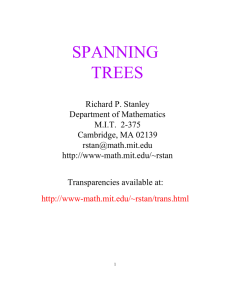
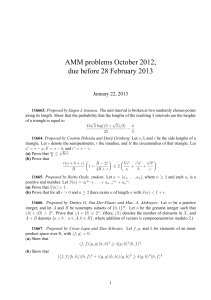
![5.5 The Haar basis is Unconditional in L [0, 1], 1 < 1](http://s2.studylib.net/store/data/010396305_1-450d5558097f626a0645448301e2bb4e-300x300.png)
